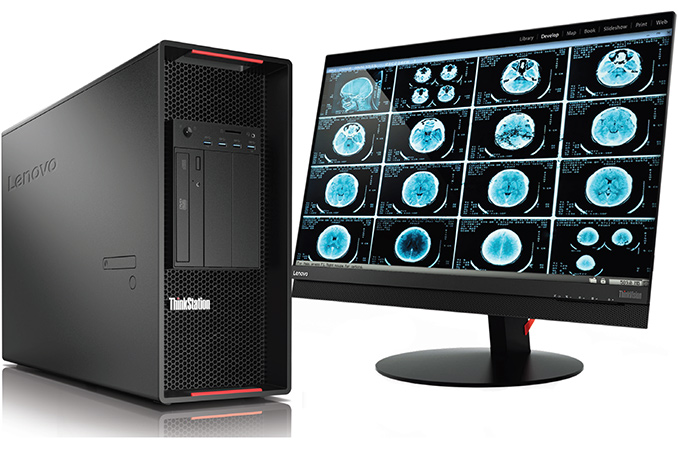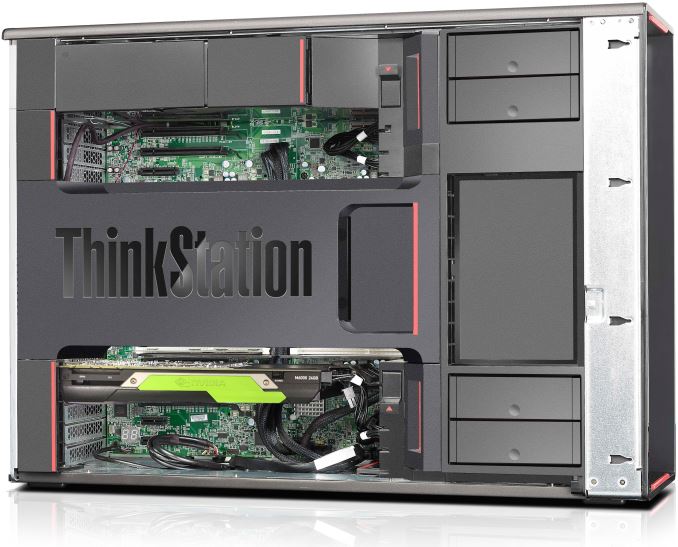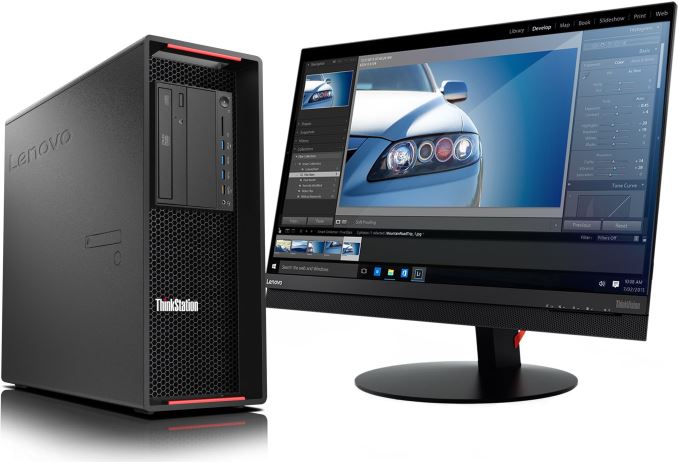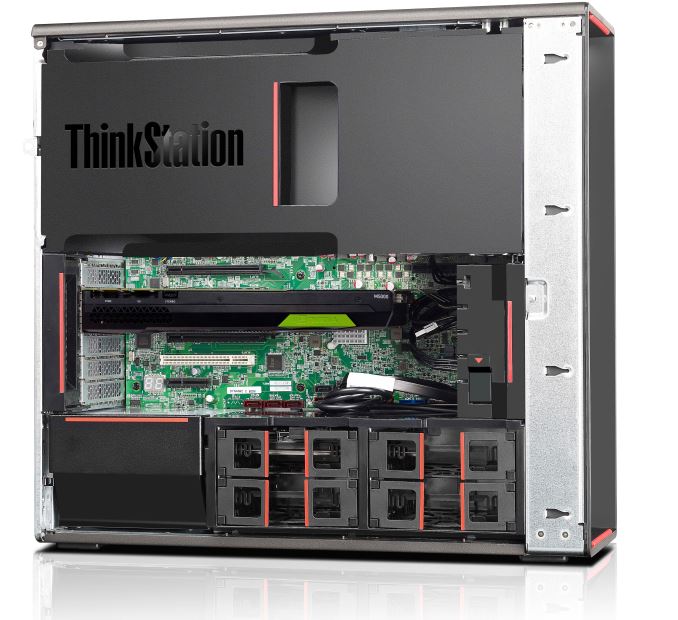Lenovo Upgrades 2-Way ThinkStation Workstations with Intel Xeon E5 v4 CPUs
by Anton Shilov on April 1, 2016 9:45 AM EST
Lenovo this week upgraded its range of 2-way workstations with Intel’s new Xeon E5 v4 microprocessors as well as recently announced NVIDIA’s Quadro M6000 24 GB graphics card. The new ThinkStation P910 and P710 machines rely on the chassis and design of their predecessors and have a lot of similarities with machines introduced in 2014. However, the new systems have a number of improvements in addition to more powerful CPUs and GPUs.
Read our review of the design of the Thinkstation P900 (E5 v3 version) here: http://www.anandtech.com/show/9214/the-lenovo-thinkstation-p900-workstation-review-design-101
The new Lenovo ThinkStation P710 and P910 workstations are based on the Intel C612 platform controller hub (PCH) and are compatible with various Intel Xeon processors in LGA2011-3 packaging, including the latest Xeon E5 v4 (also known as the Broadwell-EP). Both systems support up to two Xeon processors, which gives their owners up to 44 physical cores in total (or up to 88 threads with the HyperThreading enabled). The P910 machine can also house up to three NVIDIA Quadro or NVIDIA Tesla graphics or compute cards to handle professional graphics programs and simulation applications including three M6000s. The P710, by comparison, can support a single M6000 or up to three M2000 GPUs. To better cool-down hot components, Lenovo’s P-series workstations feature a special “tri-channel cooling” technology, which can quickly increase airflow in one of the “channels” to apply cool air to particular pieces of hardware, but not to all components in the chassis, thus, avoiding excessive noise.
The full-size Lenovo ThinkStation P910 features 16 DDR4 DIMM slots and can install up to 1 TB of RAM (thanks to the new Xeon CPUs, DDR4-2400 modules are now supported). The system can also be equipped with up to 14 internal storage devices (RAID 0, 1, 5, 10 is supported), including four M.2 SSDs (which are installed into special Flex adapters, which are then plugged into PCIe x8 Flex connectors) and up to 10 2.5” and 3.5” HDDs in order to provide both speed and capacity. The ThinkStation P910 also has Flex Bay, which is designed to support an optical drive and a 9-in-1 media card reader, or the Flex module, which holds a 9.5 mm ODD, a 29-in-1 media card reader, eSATA and Firewire connectors. In order to support power-hungry processors, graphics cards, massive amount of RAM and storage as well as other devices, the P910 comes with a 1300 W PSU that should deliver the right amount of power even to the most demanding components and configurations.
The ThinkStation P910 should be very similar to the ThinkStation P900, but with a couple of important additions such as Thunderbolt 3 and Wi-Fi 802.11ac. While Intel's Haswell-EP and Broadwell-EP processors feature the same packaging and Intel said that the new chips should be compatible with the LGA2011-3 sockets, Lenovo itself does not offer its ThinkStation P900 with new CPUs. The Xeon E5 v4 will be installed exclusively into the P910 and P710 and it is unclear whether the PC maker plans to release new BIOS revisions for its previous-gen workstations to enable upgrades.
The Lenovo ThinkStation P710 does not have the vast expansion capabilities of the P910 because it is generally more compact, nonetheless, it is still a very robust 2P workstation. The P710 sports 12 DDR4 DIMM memory slots and up to 384 GB of RAM, can be equipped with up to 12 storage devices (two M.2 SSDs [because the system has only one Flex connector], up to 10 2.5”/3.5” HDDs) and a Flex module. Since the P710 is positioned as a compact 2P machine, it can be equipped with a 490 W, 650 W or 850 W PSU in a bid to balance performance and noise levels.
Both new ThinkStations from Lenovo support all the features and technologies of their predecessors, such as tool-less upgrades (even the PSU can be replaced without tools), a USB diagnostics port and so on (these features are described in our P900 review). What is different is that the P710 and the P910 workstations can also be optionally equipped with an Intel 802.11ac card (2x2, 2.4 GHz/5GHz + Bluetooth 4.0) as well as Intel’s 'Alpine Ridge' Thunderbolt 3/USB 3.1 controller (which will support one USB type-C port). The addition of TB3 and a wireless module suggests that we are dealing with updated motherboards inside the new workstations, but Lenovo yet has to confirm this.
Lenovo’s ThinkStation P710 and P910 workstations should hit the market in the coming weeks after the company finishes their certifications with key ISVs. Prices of the new systems will start at $1600 – $1800, but configurations with two CPUs, professional graphics cards, a lot of RAM and multiple storage devices will easily cost $15000 and higher.
Clarification 4/5: Originally this news article stated the P710 could accommodate up to three M6000 GPUs. The article has been updated to clarify that due to size, the P710 can have up to three M2000s or a single M6000.
Source: Lenovo




















16 Comments
View All Comments
ltcommanderdata - Friday, April 1, 2016 - link
I asked this in the Xeon E5 v4 review article but didn't see a response. I'm wondering what the Windows support situation is for Broadwell-EP for workstation use? Microsoft said Broadwell is the last fully supported processor for Windows 7/8.1 (support for all systems not just specific ones on a list and receiving all security updates not just ones classified as critical). Skylake is getting transitional support (only specific systems on a support list and only until 2018 and afterward only critical security updates) and Kaby Lake will not be supported. So how does Broadwell-EP fit in? Is it lumped in with Broadwell and is fully supported or will it be treated like Skylake with limited support?And planning for the future, will Skylake-EP get the same basic Windows 7/8.1 support as other Skylake processors or will it not be supported at all since it'll presumably be released after Kaby Lake and will be using a new chipset?
JoeyJoJo123 - Friday, April 1, 2016 - link
"Support" in quotation marks. Windows 7 can be installed to x86 processors, and both Broadwell series and Skylake series processors are x86 processors. For the course of this post, I'll speak about Skylake series processors, which are officially "Windows 10 only" according to Microsoft and Intel, but this should apply to Broadwell series processors as well, which you're interested in.You can install Windows 7 to Skylake-series processors without too much trouble. On some motherboards, attempting to install Windows 7 via USB media, using USB-based mouse and keyboard may result in issues, particularly if these are all connected to USB 3.0 ports. ASRock and Intel have published their own utilities for slipstreaming USB 3.0 drivers into the Windows installation media so that mouse and keyboard support is available during the installation process:
http://www.asrock.com/microsite/Win7Install/index....
https://downloadcenter.intel.com/download/25476/Wi...
As far as extended support, such as "support" for Intel's enhanced Skylake Speed Shift is unique to Windows 10. Not sure what Speed Shift is? Check out this other AnandTech article:
http://www.anandtech.com/show/9751/examining-intel...
Is Speed Shift necessary for usage of Windows installations on Skylake-series processors? No, not really.
Then you may ask, "But what about security patches"?
Allowing Windows 10 telemetry unfettered access to the system data on the machine to phone back home to Microsoft information farming servers is more of a security vulnerability than just about anything Microsoft/Intel might want to issue a patch for. Any packet sniffing in between the source and destination that can decrypt the transmission or any breach to Microsoft's own servers (or the NSA's, for that matter) and your data's out in the open.
You'll still get general OS patches, but anything specific to Skylake may not apply.
bill.rookard - Friday, April 1, 2016 - link
Gosh, and I wonder why I keep my pretty darn ancient PCI USB 2.0 card sitting around in my parts drawer. I would imagine that it would probably work right off the bat and thus avoid the USB 3.0 issues.I should try it one day and see how that works.
yuhong - Friday, April 1, 2016 - link
Yes, that should work and gets you EHCI that is compatible with Win7.Arnulf - Saturday, April 2, 2016 - link
Good luck finding a decent board with a PCI slot :-(yuhong - Friday, April 1, 2016 - link
You really don't know that they use TLS for the telemetry transmissions?ltcommanderdata - Saturday, April 2, 2016 - link
Thanks for the installation tips.Some of the concern with Windows 7/8.1 support for me is legal. Whether as a contractor the IT departments or security auditors of companies I would work for would frown upon me using a Skylake system because it's not fully supported and only receives critical rated security updates and not other security updates that are rated important, moderate or low. So it looks like Broadwell-EP will be the last/fastest option for those wanting a fully supported system that can sole-boot or multi-boot Windows 7.
zodiacfml - Saturday, April 2, 2016 - link
I read somewhere that MS reverted and announced support for Skylake.yuhong - Monday, April 4, 2016 - link
Extended Skylake support until 2018 I think.extide - Friday, April 1, 2016 - link
When MS says they are not supporting Skylake on Windows 7 DOES NOT MEAN it won't work. It just means they are not going to add any specific support for that processor in the older OS's. They are not adding in the speed shift support, essentially.For some reason the press has not made this very clear, and many people are freaking out thinking that there will be a hard break here will stuff will straight up not work. That is not the case.
Broadwell has no new OS level features over Haswell (unlike Skylake with speed shift) so there is nothing special about Broadwell to the OS. As the poster above mentions, they are all x86 cpu's and will all still work with x86 OS's.